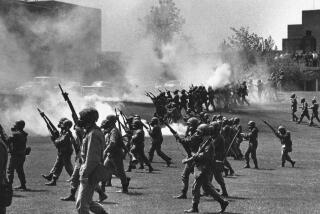A Witness to Rebellion and Massacre : Romania: ‘In just a few seconds, 30 to 40 people fell in front of me, wounded or dead. It was a moment of stupefaction.’
- Share via
This account of events in Timisoara, Romania, last weekend was provided to Radio Free Europe by a Romanian-born physician who lives in Austria and was visiting family members in Timisoara at the time. He has asked to remain anonymous to protect his family. This account was written before the later uprisings in Bucharest.
The starting point of this situation was (Reformed Church minister and human rights activist the Rev. Laszlo) Tokes, who had the courage to ask the president of the country to improve freedom and life in Romania.
To protest the threatened arrest of Tokes, the population rose slowly, first by the hundreds and then by the thousands. The culminating point was (last) Saturday, when thousands gathered in Timisoara’s Maria Square and the surroundings, quietly waiting to see what would happen next.
On Saturday night, the demonstration suddenly turned into a genuine revolutionary action. The crowds began chanting, “Down with (Romanian President Nicolae) Ceausescu,” “We are hungry!” “Come with us,” “Ceausescu . . . Freedom, where is it?” The crowds started breaking the shop windows, setting fires, ravaging the commodities available in small amounts in these shops.
By early morning, spirits quieted down. However, on Sunday, thousands upon thousands of people were milling around between Maria Square, the Cathedral, the Opera, Hotel Continental and the County Council. They were chanting slogans, calling for food, for freedom.
They broke the windows of bookshops, removed Ceausescu’s books and set them ablaze. They attacked the local government offices, threw down Ceausescu’s portrait and trampled on it. A fire truck, sent to scatter the demonstrators, was overturned in a few minutes.
The demonstration took on proportions incredible to us, Romanians. It was wonderful. Romanians were defending themselves, claiming their rights in an organized, massive way.
Around 2 p.m., troops turned up. They tried to barricade various access roads to the center of the town. At first it looked like a child’s game: Now the soldiers were withdrawing, now the demonstrators were advancing. No one could foresee what was going to happen.
Soon the soldiers began being aggressive. They started thrusting their armored vehicles into the crowd, charging the people with their bayonets and hitting them with rifle butts.
Tanks rolled over cars and people, crushing them. I saw flattened women, women who were too old to run away, crushed by tanks.
Cracks that could only be shots were heard everywhere. Ambulances and cars, horns blaring, were carrying dead and wounded, speeding toward the county hospital. No one will ever know how many.
At 8 p.m. I was marching in a row of demonstrators, led by the bearer of a Romanian flag. There were calls for freedom: “Down with Ceausescu!” People were demanding food and shouting, “Come with us!” There was a revolutionary mood.
The troops stopped the rows and called on them to withdraw, saying otherwise the soldiers would have to shoot. No one believed them. Shouts were heard: “How could they shoot the people? The army is meant to fight the enemy!” Women yelled that their husbands were among the military, and they could not believe that these men would shoot women.
A call was heard again that the order was to shoot. Nobody withdrew.
Suddenly, machine guns and rifles started rattling. In just a few seconds, 30 to 40 people fell in front of me, wounded or dead. It was a moment of stupefaction.
The crowds tried to withdraw. But the thousands at the back were advancing, chanting slogans. To our astonishment, the rows were allowed to pass. Afterwards, the riot in the center of the town was in full swing. Shops were set on fire. Slogans were chanted. The mood was that of a national holiday.
But gunfire kept rattling until 4 a.m. Tram cars were laid across the streets to stop the tanks. However, the troops could still advance. Toward dawn, many people had withdrawn. There were a great many wounded. There were heaps of dead and blood all over the place.
Early the next day (Monday), the city was relatively quiet. But tanks, soldiers, militiamen were everywhere. All government and party offices, the post office included, were closed. Splinters of glass were scattered all over the streets. Pavements were damaged by the treads of the tanks.
Thousands of people stood around bewildered, dumbfounded, deceived by the turn which the peaceful revolution was taking. They had hoped to acquire a certain measure of freedom through peaceful means, just as East European peoples--Czechoslovakia, Bulgaria--had succeeded in doing, without any bloodshed.
More to Read
Sign up for Essential California
The most important California stories and recommendations in your inbox every morning.
You may occasionally receive promotional content from the Los Angeles Times.













